Email marketing is a strategy where marketers and businesses create and send email campaigns.
Email marketing is a strategy where marketers and businesses create and send email campaigns. This direct contact helps you increase sales with existing customers and generate leads for potential customers. Email content typically ranges from brand news and new product updates to special offers.
The process involves capturing customer (or potential customers) emails, then sending them specific sequences or email newsletters designed to encourage further engagement or purchases.
Email is still one of the most effective marketing methods available. Compared to social media marketing, email gets you nearly five times more buyers than other marketing channels. Plus, email marketing generates a $42 return on investment (ROI) for each dollar spent.
This guide will help you understand the basics of email marketing and has nine tips to help boost the effectiveness of your campaigns.
1. Choose the Right Email Marketing Software
First of all, let’s talk about email service providers (ESPs). Choosing the right email software is important because different services often have specialties or a unique selling point. Not only that, but you want to make sure your investment is worth it.
For example, many customer relationship management (CRM) software have built-in email marketing tools if you prefer an all-in-one solution. However, you might want to use software dedicated to email marketing with specific email tools and features to help you grow and manage your subscriber list.
These email-specific software options, such as Constant Contact, often offer similar features at a cheaper rate than full CRM solutions and use tiered pricing based on how many email subscribers you have. So, choosing the right email marketing software boils down to answering two main questions:
- Does my business need a whole CRM suite, or could we just use an ESP?
- Would using subscriber-based pricing be more cost-effective?
These two questions can help you significantly narrow your list of potential software providers to adopt down.
2. Always Build Your List
We can’t understate the importance of list-building in email marketing. If you don’t have people on your list, then who are you going to email? And the more email sign-ups you get, the more opportunities you have to make sales.
So let’s take a look at some ways you can build your list:
- Use email capture or a signup form on your website. You can place signup forms on pop-up windows, static pages, and your blog posts, like so:

Example from Fit Small Business’s website
- Use a POS system that captures emails. Even if you’re a brick-and-mortar store, the demand for digital receipts is on the rise, with 89% of respondents to one survey suggesting they would like the option. POS systems like Square offer the digital receipt feature.
- Ask for emails at checkout. If nothing else, you can also simply ask customers if they’d like to join your email list at the point of purchase, both in-store and through online opt-in checkboxes.
Once you’ve chosen your email marketing software and provided opportunities for people to sign up (as well as unsubscribe), what then? Next are tips on what to do after these initial steps.
3. Leverage Marketing Automation
Manual email management is cumbersome—and near impossible if you have growth goals. That’s where marketing automation comes in.
Automating various email processes can help you save both time and money, as well as increase email effectiveness—single message autoresponder emails have seen just over 98% open rates and 37% click-through rates.
As a small business retailer, there are a few types of emails you can automate to build customer relationships and generate leads, including:
- A post-purchase email sequence to help upsell or cross-sell other products or gather feedback. See this email from Bellroy, for example:
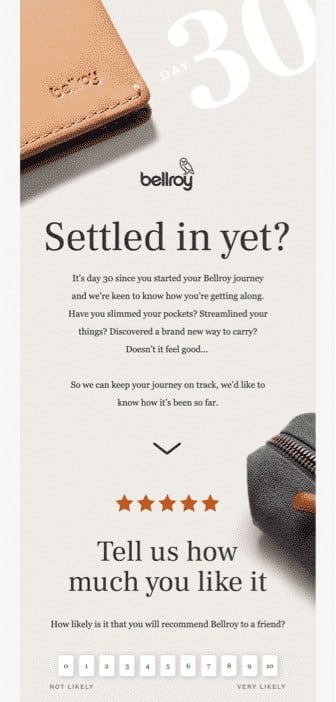
(Image source: Really Good Emails)
- Transactional emails, such as order confirmation and shipping information, to help recover abandoned carts or re-invite inactive users. Most, if not all, ecommerce platforms provide automated transactional emails.
- Welcome emails to encourage product or brand engagement. Welcome emails get, on average, an 86% open rate and around 25% click-through rate. Check out this example from Cat Caboodle:
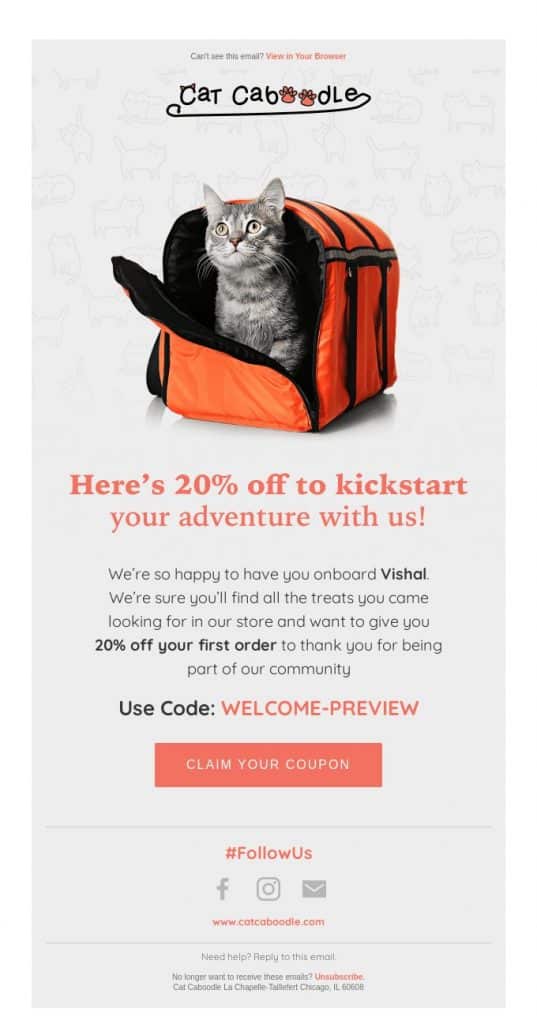
(Image source: Really Good Emails)
Email campaign sequences aren’t the only part of the email marketing strategy you can automate either—let’s take a look at segmentation.
4. Segment Your Email List Subscribers
As a small business, you might think you’d be OK with having one big list and sending the same emails to everyone. However, if you’re looking to boost your conversion rates, then you’re going to need to use segmentation. Segmentation is when you group your list based on shared attributes.
There are two main ways of going about email list segmentation:
- Creating customer profiles and templates and manually organizing your lists
- Using behavior-based automatic segmentation
Customer profiles allow you to have more hands-on control around who you send certain emails to and when. Automated segmentation, like that offered by Sendinblue, can create lists based on which landing page or call-to-action (CTA) new subscribers used, which product category they purchased, etc. Here’s a basic example of an automated segmentation flow:
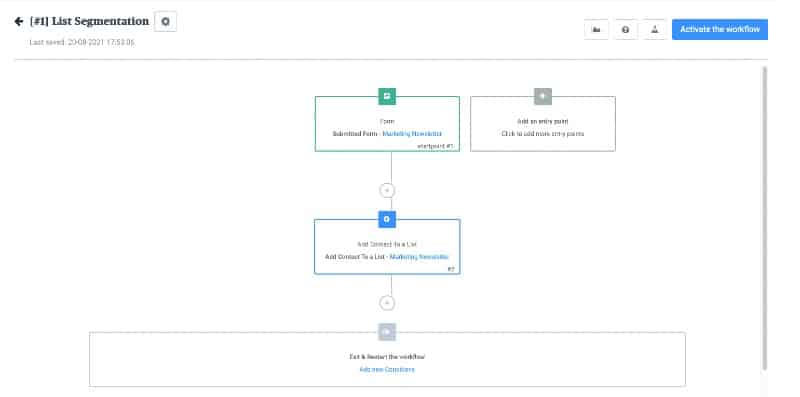
In the above example, when people sign up through a specific form, they’re added to a list—this enables the marketer to send relevant messages to various groups of subscribers.
5. Personalize Your Messages
Segmenting your lists is part of a bigger element in your marketing strategy: personalization. In fact, almost three-fourths of marketers say personalization in emails has helped them increase engagement—generating a median ROI of 122%.
Personalization comes in many forms, and your approach varies depending on your industry, but it’s particularly important in retail. Many businesses simply change the “Hey there!” or “Dear Customer” with the customer’s name, but effective personalization goes far beyond that.
While addressing people by name might inspire some customer loyalty, one way to boost retention is to include purchase behavior personalization, such as recommended products, in the email design. Take Crate and Barrel for example:
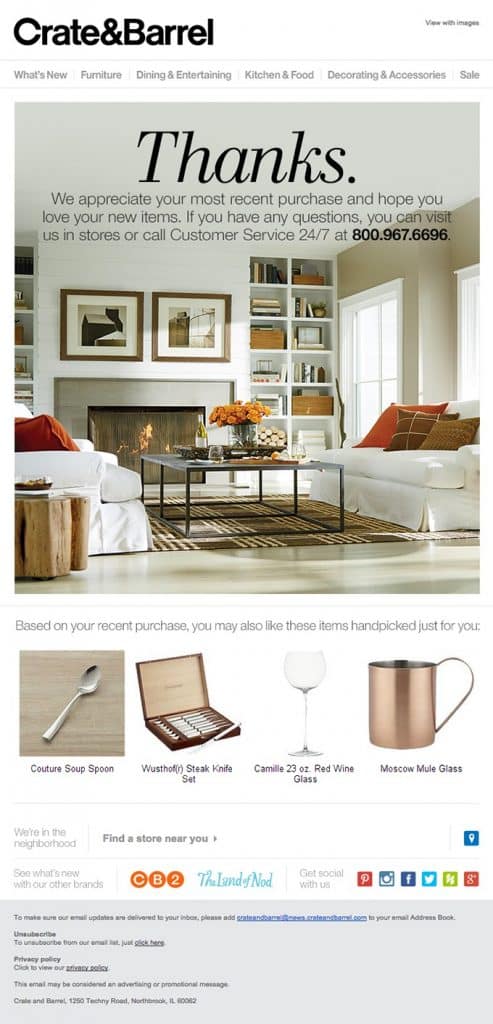
(Source: Really Good Emails)
The “based on your recent purchase” block is one type of personalization that has increased by 60% in 2020, compared to 38% in 2019. And for good reason—it works.
6. Optimize Your Subject Lines
Beyond personalizing the body of the email, another key area to focus on is the subject line (and, by extension, the subject description). Optimizing your subject line is so important because it can often make or break your open rates, and with nearly 320 billion emails projected to be sent and received in 2021, it’s more important than ever to stand out.
There’s plenty of speculation about how many characters should be in your subject line, whether or not to use emojis, capitalize words, etc. However, research by GetResponse shows those things don’t matter. What truly matters is knowing your customers and what’s more likely to compel them into opening your email.
Take these subject lines, for example:

The above subject lines are a mix of behavior-based personalization and general discount announcements, as well as knowing the language of their (younger demographic) subscribers.
7. Integrate Other Platforms and Marketing Channels
As important as email is, you should still consider it just one small piece of the marketing puzzle. And while marketing existed in channel-inspired siloes, modern retailers are taking a more holistic and integrated approach. Customers don’t compartmentalize interactions with your brand based on channel, so nor should you.
According to research from Catalyst Digital, 66% of online purchasers’ pre-purchase touchpoints were online (spread across different channels) and 31% were offline.
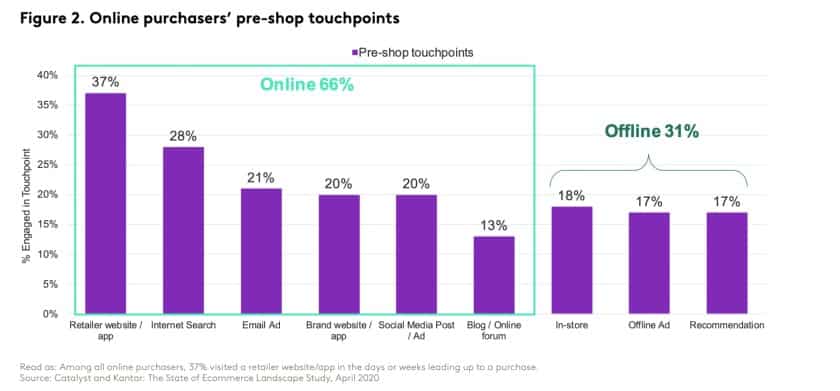
(Source: Catalyst Digital)
This spread of touchpoints means savvy retailers need to adopt an omnichannel approach by integrating email alongside other platforms and channels. Here are a few ways you can get it all to work together:
- Connect your POS. Earlier, we mentioned using a POS system that captures emails—you can also use this method to register customers in loyalty programs.
- Sync with other advertising initiatives. Instead of promoting your products and services, your business could champion a nonprofit cause (or other types of partnerships) where you can cross-promote and capture new subscribers.
- Use your email list to build lookalike audiences on social media. When you run ads on platforms like Facebook, Twitter, Instagram, and LinkedIn, you can refine your target audience using your email list to get the best chance of finding new customers.
Taking an omnichannel approach by considering your other platforms and channels is the best way to ensure you can meet the customer wherever they want to meet you.
8. Add Value
As you work on gaining new subscribers, don’t forget about the people already on your list. To keep them from unsubscribing, you’ll need to make sure you’re adding valuable content to their lives and not just sending out endless promotions.
Of course, value is subjective—some audiences would like some entertainment or humor as a value-add, while others prefer educational content. Check out this example from Judy:

(Source: Really Good Emails)
While its CTA involves clicking through to its online shop, the email content itself is educational and, in this case, potentially life-saving.
The key to making sure your content is adding value is knowing your audience by going out of your way to finding out what they want (not just assuming you already know). If you’re stuck, you can use a poll on social media or ask for feedback at the end of your emails. You can even send out an email survey to your list.
9. Review Your Analytics and Make Adjustments
One final tip is to always be open to making adjustments to your emails by reviewing your analytics and testing. Analyzing your email performance is essential; otherwise, you end up stumbling through your strategy blind and not making data-informed decisions.
Every email marketing platform will have analytics for each email or an overall performance dashboard:

An example of overall performance analytics on an individual email send
From there, you can use metrics such as open rate, clicks, and opt-outs (unsubscribers) to help you understand what type of emails your customers engage with the most and iterate new variations.
Bottom Line
Email marketing is still one of the most effective and affordable methods of engaging customers and boosting revenue. However, don’t forget that it is one of several marketing channels you should be adopting for a holistic, omnichannel presence.
The tips we’ve covered in this guide, from choosing the right email marketing platform all the way to reviewing your performance, should help you not only get started on your email marketing strategy but also thrive.
►►► See our products: Magento POS, Shopify POS, BigCommerce POS , Woocommerce pos, Multi source inventory management , magento 2 pos, netsuite pos and START A FREE TRIAL NOW !
►►► Other ecommerce apps : BigCommerce Automation App Platform, Bigcommerce Backorder Management, Shopify Automation App
Comments
Post a Comment